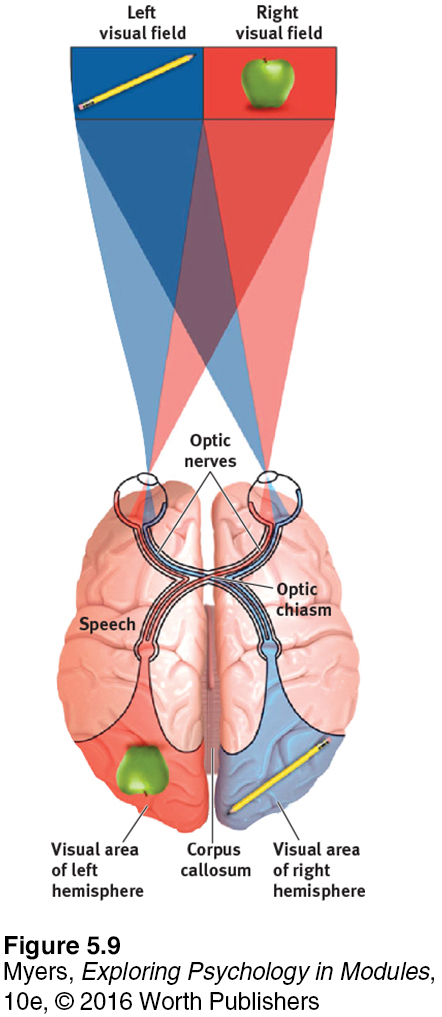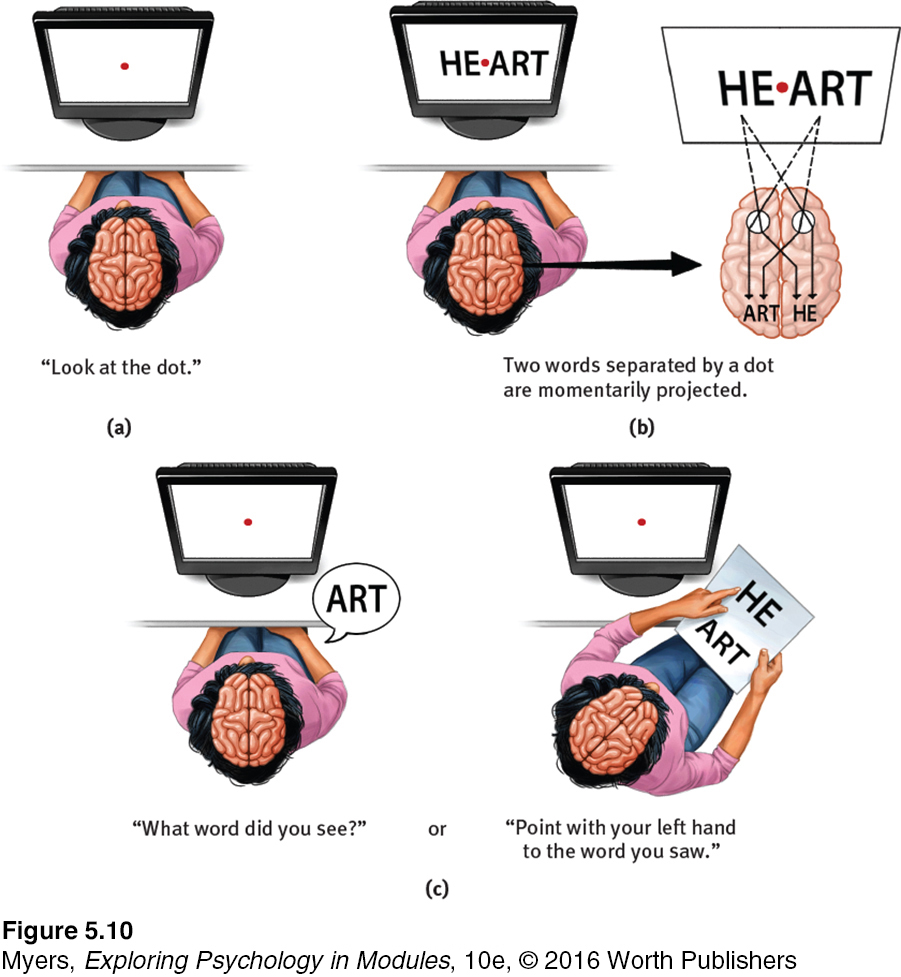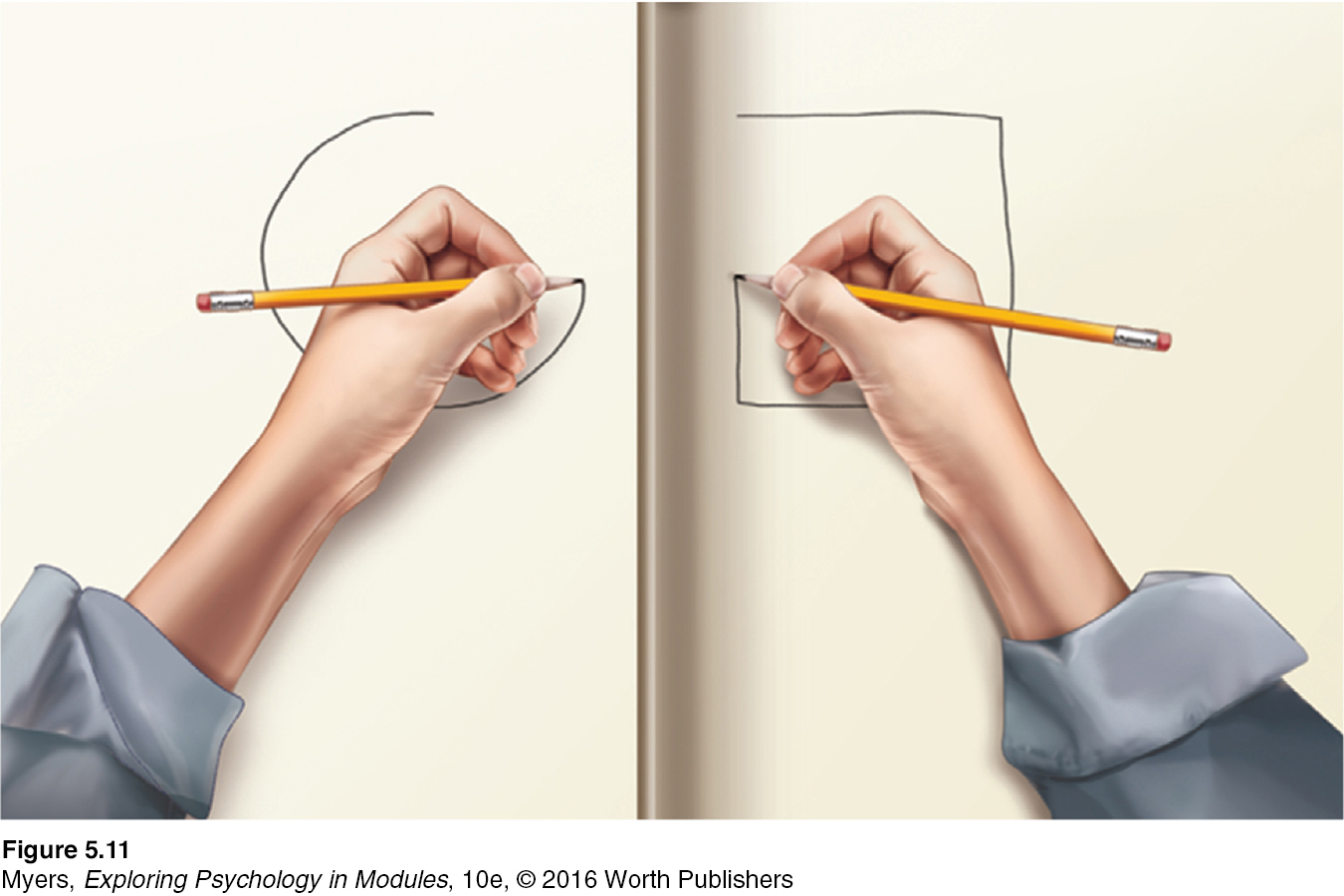5.2 Our Divided Brain
5-
Our brain’s look-
Splitting the Brain
62
corpus callosum [KOR-
In 1961, Los Angeles neurosurgeons Philip Vogel and Joseph Bogen speculated that major epileptic seizures were caused by an amplification of abnormal brain activity bouncing back and forth between the two cerebral hemispheres, which work together as a whole system. If so, they wondered, could they end this biological tennis match by severing the corpus callosum, the wide band of axon fibers connecting the two hemispheres and carrying messages between them (FIGURE 5.8)? Vogel and Bogen knew that psychologists Roger Sperry, Ronald Myers, and Michael Gazzaniga had divided cats’ and monkeys’ brains in this manner, with no serious ill effects.

split brain a condition resulting from surgery that isolates the brain’s two hemispheres by cutting the fibers (mainly those of the corpus callosum) connecting them.

So the surgeons operated. The result? The seizures all but disappeared. The patients with these split brains were surprisingly normal, their personality and intellect hardly affected. Waking from surgery, one even joked that he had a “splitting headache” (Gazzaniga, 1967). By sharing their experiences, these patients have greatly expanded our understanding of interactions between the intact brain’s two hemispheres.
To appreciate these findings, we need to focus for a minute on the peculiar nature of our visual wiring, illustrated in FIGURE 5.9. Note that each eye receives sensory information from the entire visual field. But in each eye, information from the left half of your field of vision goes to your right hemisphere, and information from the right half of your visual field goes to your left hemisphere, which usually controls speech. Information received by either hemisphere is quickly transmitted to the other across the corpus callosum. In a person with a severed corpus callosum, this information-
Knowing these facts, Sperry and Gazzaniga could send information to a patient’s left or right hemisphere. As the person stared at a spot, they flashed a stimulus to its right or left. They could do this with you, too, but in your intact brain, the hemisphere receiving the information would instantly pass the news to the other side. Because the split-
In an early experiment, Gazzaniga (1967) asked split-
63

When a picture of a spoon was flashed to their right hemisphere, the patients could not say what they had viewed. But when asked to identify what they had viewed by feeling an assortment of hidden objects with their left hand, they readily selected the spoon. If the experimenter said, “Correct!” the patient might reply, “What? Correct? How could I possibly pick out the correct object when I don’t know what I saw?” It is, of course, the left hemisphere doing the talking here, bewildered by what the nonverbal right hemisphere knows.
A few people who have had split-
64

“Do not let your left hand know what your right hand is doing.”
Matthew 6:3
 IMMERSIVE LEARNING Have you ever been asked if you are “left-
IMMERSIVE LEARNING Have you ever been asked if you are “left-
When the “two minds” are at odds, the left hemisphere does mental gymnastics to rationalize reactions it does not understand. If a patient follows an order (“Walk”) sent to the right hemisphere, a strange thing happens. The left hemisphere, unaware of the order, doesn’t know why the patient begins walking. If asked why, the patient doesn’t reply, “I don’t know.” Instead, the left hemisphere improvises—
RETRIEVE IT
Question
Y1v6QtP8KrCLdh037DQDuEwTCNm2TUi51A7wTI6asWpqE5jh6IFgWUyXZsCHJkIzGO30ui/YpqLjqYHCWyLJbbDlq5K7v+7o1iwH1l6baUiz/Ka0/0ItcuETNgJEh5/x64Al+0L7AyaYMA0incp4OBoIUEXVdTDL52ttVqEXfofj0nXhb14YKt4laDWlxplO7aIGT/lnmxHpNg9hku7i0H6tNcOau2XuQjGhb2pX3Fmb5QticlTdBMeJW7pMejw3CdKzp6udDQGH8ef6RYRKqh+5sy4amGxLr0MgsqSsUVNrCMCmVdL4SIHskSYkf46IZTlQ2xyboiDf8qIR0bNMvpzJMxJ8gORiYBNkr0SO+kA=Right-
So, what about the 99.99+ percent of us with undivided brains? Does each of our hemispheres also perform distinct functions? Several different types of studies indicate they do. When a person performs a perceptual task, for example, brain waves, bloodflow, and glucose consumption reveal increased activity in the right hemisphere. When the person speaks or calculates, activity usually increases in the left hemisphere.
A dramatic demonstration of hemispheric specialization happens before some types of brain surgery. To locate the patient’s language centers, the surgeon injects a sedative into the neck artery feeding blood to the left hemisphere, which usually controls speech. Before the injection, the patient is lying down, arms in the air, chatting with the doctor. Can you predict what probably happens when the drug puts the left hemisphere to sleep? Within seconds, the person’s right arm falls limp. If the left hemisphere is controlling language, the patient will be speechless until the drug wears off. If the drug is injected into the artery to the right hemisphere, the left arm will fall limp, but the person will still be able to speak.
To the brain, language is language, whether spoken or signed. Just as hearing people usually use the left hemisphere to process spoken language, deaf people use the left hemisphere to process sign language (Corina et al., 1992; Hickok et al., 2001). Thus, a left hemisphere stroke disrupts a deaf person’s signing, much as it would disrupt a hearing person’s speaking (Corina, 1998).
Although the left hemisphere is skilled at making quick, literal interpretations of language, the right hemisphere excels at making inferences (Beeman & Chiarello, 1998; Bowden & Beeman, 1998; Mason & Just, 2004). It also helps us modulate our speech to make meaning clear—
 For a helpful animated review of split-
For a helpful animated review of split-
Simply looking at the two hemispheres, so alike to the naked eye, who would suppose they contribute uniquely to the harmony of the whole? Yet a variety of observations—
How does the brain’s intricate networking emerge? How does our heredity—